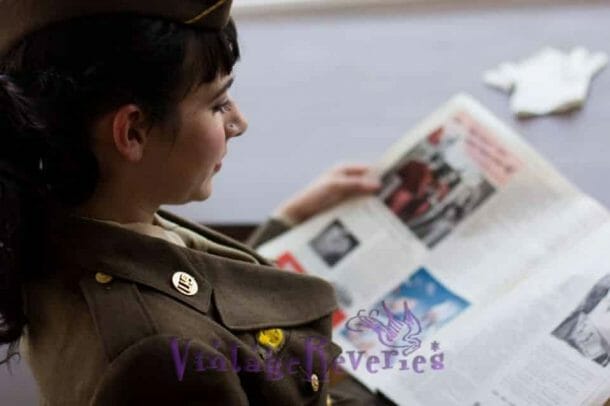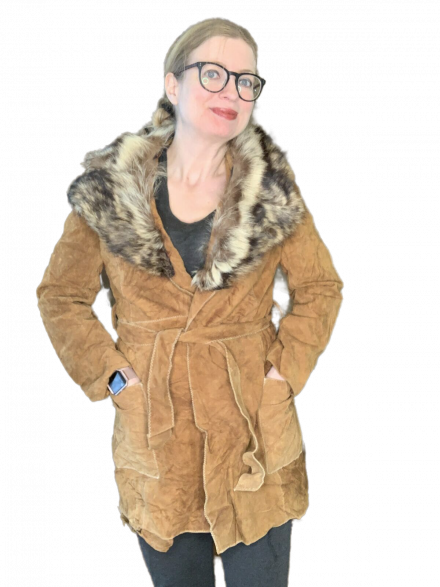
1930s women’s suit and coat styles

The 1930s were an iconic decade for women’s fashion, a time when style combined elegance with practicality, adapting to the social and economic shifts of the Great Depression. This ethos of affordable sophistication is perfectly reflected in the stunning offerings from the 1935 Chicago Mail Order Company Catalog, where tailored, neat, and affordable choices made it accessible for women from different walks of life to stay fashionable.
Timeless Appeal of Blue and Tweed
One highlight of the 1935 catalog is the tailored suit set crafted in blue tweed, a popular fabric choice in the mid-1930s thanks to its durability and versatility. The suit, which included a coat, skirt, and vestee, could be purchased for only $5.98—a price that reflected the need for budget-friendly options during the economic constraints of the era. Tweed was particularly beloved because it was not only stylish and appropriate for various occasions but also practical for women juggling work, family duties, or social activities.
Matching accessories completed the chic ensemble, with hats being offered for just 77 cents. The catalog’s matching hat, notable for its three distinctive modes, highlighted the 1930s’ emphasis on accessorizing as an art form. Hats during this era were often an essential part of an outfit, reflecting individual personality while maintaining elegance.
Seasonal Styles and Fabrics in Summer 1935
The catalog didn’t stop there. It showcased summer-ready options, such as a cotton waffle cloth jacket perfect for warmer weather. Cotton was a leading choice for summer outfits due to its breathability and comfort. Outerwear also featured prominently, as seen in the caped coat made from treebark crepe—an innovative fabric admired for its unique texture and luxurious yet lightweight feel.
Crepe dominated women’s wardrobes in the 1930s. It was a versatile and flattering fabric used for everything from dresses to outerwear. Its soft drape allowed it to take on elegant silhouettes, as seen in this catalog. This popularity was bolstered by the decade’s shift toward more fluid and streamlined designs, with less structure compared to the heavily corseted looks of earlier decades.
The Rise of “Sporty Suits” in 1930s fashion
Sporty suits also took center stage, marking a growing trend in mid-1930s fashion. Women were increasingly engaging in activities outside the home, and clothing designers responded with outfits that combined comfort, mobility, and style. These suits, often made from practical fabrics like tweed and wool, featured clean lines and sharp tailoring. They reflected a broader cultural shift—women were stepping into roles previously dominated by men, including taking on jobs during the Great Depression, and their clothing had to keep up with these new lifestyles.
The catalog additionally offered sizing options that were inclusive and noteworthy for their time. “Stout sizes 37-53 bust” was a more flattering way of labeling larger sizes in an era when fashion was beginning to break away from restrictive notions of beauty. This acknowledgment of all body shapes reflected not only a market demand but also a celebration of diversity in women’s experiences and forms.
Fashion: Affordability and Accessibility
What stood out about mail order catalogs like this one was their accessibility. In 1935, options like these allowed women from rural and urban areas alike to stay in touch with fashion trends. Mail order catalogs were a revolutionary way to “shop from home” in an era without modern convenience stores or the internet. They offered a glimpse into aspirational living while ensuring that affordability was front and center. The prices alone—$5.98 for a full suit and 77 cents for a hat—underscored how clothes were designed not just for the elite but for the everyday woman, making high fashion styles accessible to a broader audience.
1930s Cultural and Social Context
The 1930s were a transformative period for women’s fashion. Coming off the excesses of the 1920s, the Great Depression ushered in a new era of frugality, creativity, and practicality. Women’s suits and coats like those in the 1935 catalog embodied this transition. Clothing became a way to express individuality while adhering to the cultural expectations of neatness and propriety. Skirts became longer and straighter, sleeves modest and functional, and fabrics sturdier, reflecting a shift towards durable, timeless designs.
Additionally, women’s fashion of the 1930s was influenced heavily by Hollywood. The big screen introduced glamorous yet wearable designs to a mass audience, with stars like Joan Crawford and Katharine Hepburn inspiring audiences with their impeccably tailored suits and classy outerwear. Styles trickled down through catalogs, stores, and even homemade tailoring, as many women learned to sew due to necessity during the Depression.
Bring Back the 1930s Glamour
These beautifully tailored, wallet-friendly styles from the 1935 Chicago Mail Order Company Catalog give us a vivid snapshot of 1930s practicality and elegance. Whether it was the sporty tweed suits, the luxurious treebark crepe coats, or the affordable and versatile accessories like hats, women of the 1930s managed to look polished despite a difficult economic climate. Not only was their fashion a reflection of their resilience, but it also laid the foundation for modern fashion movements that embrace function, inclusivity, and style.
So next time you spot a blue wool vintage suit or an elegant textured outerwear piece, imagine the stories it holds and the history it witnessed. These pieces are not just garments—they’re a glimpse into how fashion empowered women during one of the most challenging decades in history.






















You must be logged in to post a comment.